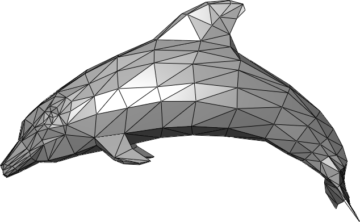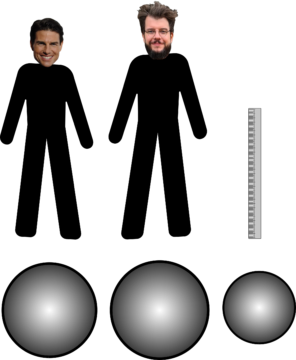by Jochen Szangolies

Children, they say, are natural scientists (although opinion on what it is that makes them so appears divided). Each of us has probably been stumped by a question asked, out of the blue, that gives a sudden glimpse into the workings of a mind encountering the world for the first time, faced with the impossible task of making sense of it. While there may be an element of romanticisation at play, such moments also, on occasion, show us the world from a point of view where the assumptions that frame the adult world have not yet calcified into comforting certainties.
The questions I asked, as a child, where probably mostly of the ‘neverending chain of why’-sort (a habit I still haven’t entirely shed). But there was one idea that kept creeping up on me with an almost compulsive quality: how do I know what’s inside things? Is there anything, or is there just a dark nothing behind their flimsy outer skin? Granted, I probably didn’t phrase it in these terms, but there was a sort of vaguely realized worry that things might just suddenly go pop like an unsuspecting balloon pricked by a prankster’s needle, exposing themselves as ultimately hollow, mere shells.
It’s not such an easily dismissed idea. All we ever see of things are surfaces reflecting light. All we ever touch are exteriors. Even the tasting tongue, a favorite instrument of probing for the curious child, tastes nothing but what’s on the outside (incidentally, here’s something I always found sort of creepy: look at anything around you—your tongue knows exactly what it feels like).
You might think it’s a simple enough exercise to discover the inner nature of things—faced with, say, the deliciously decorated exterior of a cake, in the best analytic tradition, heed your inner lobster, whip out a knife and cut right into it to expose the sweet interior. But are you then truly faced with the cake’s inner nature? No—rather, you’re presented with the surface of the piece you cut out, and the rest remaining on the cake platter.
The act of cutting, rather than revealing the inner, just creates new exterior, by separating the cut object—you can’t cut your cake and leave it whole. Whenever threatened with exposure, the inner retreats behind fresh surface.
A View From Nowhere
The exterior of things forms a natural boundary to our knowledge of them—that is, to our knowledge as gathered by experiential means, like seeing, touching, tasting, even if enhanced by various tools of analysis, such as knives or drills for opening up holes into a putative inner. But this is just a consequence of the way we exist in the world—as three-dimensional beings in a three-dimensional universe. But consider instead A. Square, the protagonist of Edwin A. Abbott’s classic satire of Victorian social stratification, Flatland. A. Square, a literal square, lives in a two-dimensional world, encountering only the one-dimensional boundaries of objects within it (and their zero-dimensional vertices, with, in the case of women, who are portrayed as one-dimensional line segments, occasionally fatal consequences due to being punctured).

We, however, floating ‘above’ Flatland, can simultaneously apprehend both surface (boundary) and interior (area) of the objects and beings populating it. Viewed from some remove along the third dimension, the Problem of the Inner, for a two-dimensional universe, evaporates.
The same is true about our three-dimensional world: a four-dimensional being, removed katawards from our three-dimensional universe, could simultaneously behold interior and exterior of every object—could see your houses outer walls, as well as all the rooms within, and even into the walls themselves. Such a being, then, could tell the difference between a three-dimensional world that is ‘all surface’, and one where there exist genuine inner natures. However, of course, they are faced with the same problem iterated one step further: four-dimensional interiors are just as inaccessible to them as three-dimensional volumes are to us.
This is an important point: we are limited, by our nature, in the kinds of knowledge that are experientially—or empirically—accessible to us; but this does not mean that these ‘hidden’ realities don’t make an important difference for the world. Even if it were possible to overcome this limit—ascending to a higher dimension, or what have you—equivalent limits would still exist. There is no neutral vantage point, from which to observe the world—the very fact of us existing as observers in the world puts limits on what is observable. The putative scientific ideal of an ‘objective point of view’ is an oxymoron: if it is a point of view, it’s not objective, but subject to the limitations of observing the world from within. The only view we have is the view from now, here.
The Map, The Territory, And All That
But now suppose that somebody were to espouse the view that, since all we ever encounter are surfaces, surfaces are all there is. What do we need interiors for, if the world seems populated entirely by exteriors? Interiors are ineluctably mysterious things: posited only, they claim, by unscientific folk-theories, inaccessible to experimental investigation. Nothing but sophistry and illusion, metaphysical baggage dragging down scientific inquiry.
As before, this idea is not easily dismissed. Indeed, it seems that if we want to rescue any notion of scientific completeness, we should jettison the problematic interior, and instead, embrace a world of polished surface. Protestations to the effect that surfaces are only made possible by interiors, that they are just the boundaries of things, and not the things themselves, that a boundary isn’t a boundary unless it is the boundary of something, are soon dismissed as confused holdovers from a pre-scientific worldview.

In support, proponents of such a worldview might point to the lush, three-dimensional landscapes created in modern computer games: everything there, from the smallest blade of grass to the highest mountain, to the player’s avatar and the non-player characters populating this world, is just surface—polygons painted with two-dimensional textures. There, the act of cutting, or blowing apart, really does create new surface (or expose prefabricated surface along predetermined fault lines).
Taken to its (putative) logical conclusion, this would mean that 3D-renderings of objects literally are the same as their real-world counterparts: there is no meaningful distinction between a stone rendered in sufficient detail and the real thing out there, in the world.
This would, surely, be a bridge too far: just because our capacities for observation are delimited by the boundaries of objects does not imply that these are all there is; it is a mere consequence of our being embedded within the world that things appear as they do. It would amount to a confusion between the world as it is, and the world as we describe it, as abstracted from our experience within it—that is, a case of mistaking the map for the territory.
Of course, nobody has (to my knowledge) seriously proposed such a view (allegations that the modern world has become all surface notwithstanding). But the lesson is one that, I think, we need to keep in mind in formulating a picture of the world that is informed by modern science, without falling into the trap of hasty overgeneralization.
Measurement And Relation
Our access to the objects of the world is not limited to mere tactile or visual interrogation of their exteriors. There is plenty of evidence that is best explained by the presence of interiors—we can take measurements of density, mass distribution, moment of inertia and the like, all of which make an explanation in terms of pure surface appear less natural. But that doesn’t mean we are entirely unencumbered in our means of access to the world.
Whenever we take a measurement, we’re ultimately comparing two objects out there in the world, either directly—as in, for instance, measuring size by means of comparison with a standard meter stick—, or indirectly, quantifying the effect one object has on another. This quantification then again proceeds via comparison—say, of the change in the length of a spring upon attaching a certain mass. The active investigation of the world involves purposeful manipulation of objects, and the quantification of their reactions.
Our knowledge of objects—that is, our empirical knowledge—then does not merely come from investigation of their surfaces, but of the interfaces, the contact surfaces they expose to the world. And ultimately, all such knowledge is relational: an object has a greater mass than another if it elongates the same spring further; comparison to a universal reference (like Le Grand K located at the International Bureau of Weights and Measures in Sèvres, Paris) then allows the setting up of a scale.
Talk about measured quantities is then shorthand for talk about relations: that I am 1.83 m tall then just says that I am 1.83 times as tall as the universal measuring stick used to define the length of the meter. Everything in the world then stands in a certain relation to me, as far as size is concerned: it is either taller or smaller than me—or perhaps, exactly as tall as I am.
We might then pose the question: if all we can measure is relation, might then relation be all there is? This is a deeply counterintuitive view, at first blush: usually, we take two things to stand in a certain relation by virtue of their properties—that is, I am taller than Tom Cruise because he is 1.7 m tall, while I am 1.83 m tall. Our sizes determine the relationship.
But now suppose that, say by dint of demonic magic, everything in the world suddenly doubled in size. I would still be 1.83 times as tall as the universal meter stick, and would still be taller than Tom Cruise by the same measure as before. If relation is all there is, then the world is underdetermined: the size relations of objects don’t suffice to fix the absolute size of any single thing. Note the asymmetry: knowing absolute sizes uniquely fixes the relations, but only keeping those relations loses information.
One might then be tempted to, again, say: well, so much the worse for absolute size. What’s it ever done for us, anyway? In fact, throw out all other non-relational (‘intrinsic’) properties along with them—they are inaccessible to our probing, so we can do without.

But the underdetermination problem is, in fact, even worse. Relations as such don’t come with an intrinsic identity: the set of relations (which we can call a ‘structure’) between me, Tom Cruise, and the meter stick is the same as between Le Grand K, a 1.83 kg mass, and a 1.7 kg mass. On the one hand, this is a fantastically useful property: that we can instantiate the same relations in different substrates means that we can use one system to model another, and thus, use a more easily manipulated system to make predictions about one not under our direct control—indeed, this is the basis of all scientific theorizing. The most highly developed example of this is the modern computer: a device within which virtually any structure can be realized, and which thus can work as a universal model.
On the other hand, this means that a knowledge based only on structure, only on the relations obeyed by the elements of a domain, is highly impoverished: indeed, as the mathematician Max Newman argued in 1928, all it ultimately tells us about the domain is the bare number of elements it contains.
We seem to be at an impasse, then: we can only access objects via their relations—they are the control surfaces exposed to our investigations. Yet, a knowledge based solely on relations, concerning only matters of cardinality, seems scarcely capable of giving rise to our highly complex and differentiated experience of the world.
Mind As The Inside-View Of Matter

Our scientific investigations reveal the relations between things, but is blind to what the great astronomer and physicist Arthur Eddington, most famous for his experimental confirmation of Albert Einstein’s general theory of relativity in 1919, called ‘the inner un-get-atable nature’ of matter. Still, we seem to know more of the world than can be deduced from mere relation. How do we reconcile these two observations?
One possibility is to admit that the world, after all, is not mere relation; that relations are just the exterior appearances of intrinsic properties, even if those properties themselves are not directly subject to our probing. It is only our situatedness as observers in the world that lets us access only relations, with intrinsic properties receding from analysis in the way the inner retreats from the cutting knife.
How does this help?—Well, while it may be impossible for us to access the intrinsic properties of objects in the external world, we have a special access to our own: they are just what is present to us in experience. The relations of the outside world then are mirrored in the relations of the elements of our experience—and thus, obtain the intrinsic nature the relations on their own lack. If you see me, Tom Cruise, and a standard meter, then the relation between these as objects of the worlds are instantiated in your experience, and hence, distinct from formally equivalent relations, such as that between three appropriate masses. The relations are the same, but they differ in the way they are present to your experience. Thus, the paucity of mere relation is overcome.
It is then just a short hop and skip to the proposal that the intrinsic properties of the world are not just what’s present in experience, but rather, that they are experiential themselves—that, in other words, the inner nature of matter is mind. This is the philosophical position known as panpsychism—the idea that, within each material object, there are mental properties already instantiated, that indeed, it is ultimately out of these mental properties that material relations are built.
For many, this is too radical a proposal, despite its conceptual neatness. What mental properties does the table my computer rests on have? What is it like to be an electron? Yet, in recent times, due to the efforts of philosophers like Philip Goff, David Chalmers, and Galen Strawson—who has argued that panpsychism is entailed by physicalism, the metaphysical position that everything is physical in nature—the proposal has come to enjoy a resurgence.
However, panpsychism lacks a certain sort of explanatory heft: faced with the question of how the rabbit of mind is pulled from the hat of ordinary matter, it just answers that it’s been in there all along. But this doesn’t tell us how the trick works. My own proposal is that the intrinsic properties only become proper mental properties once they are brought under the purview of the self-reflective von Neumann process: that it is only under the self-referential gaze of von Neumann’s design that intrinsic properties—which we can otherwise think of neutrally, as simply the bearer of the relations probed by scientific investigation—obtain their experiential sheen.
Be that as it may, I think that those who appeal to the relations that are the proper object of scientific inquiry as foundational to the world make the same sort of mistake that one would make, were one to propose that the world is all surface: the reification of the accidents of our mode of discovery. It is only because of the misguided attempt at abstracting away our own embeddedness from our exploration of the world that such a hypothesis can come to be entertained; we are confusing our mode of access to the (outside) world with the world’s being.
Realizing this makes short work of a number of currently fashionable ideas. For instance, minds can’t be uploaded to a computer for the same reason bricks can’t: because, just as the rendering of a brick in loving detail lacks its interior, the instantiation of a mind’s structure in a computer lacks the intrinsic properties that are the true objects of experience. That’s not to say minds can’t be built from silicon, just as they can be from neuronal tissue; but if they can be, they’ll be minds because of their own intrinsic nature, not because of the software they run. But a full exploration of these and related issues is best left for another time.
